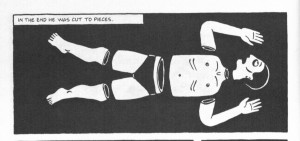Hello everyone! Over the past couple of weeks, we have been looking at the graphic narrative Persepolis by Marjane Satrapi in my ASTU class. For those of you who have not heard of this book, it is Satrapi’s powerful memoir of her childhood in Iran during the Islamic Revolution. One of the things that intrigued me most about this book was the style in which it is written. When I saw that the first book I was going to be reading in university was a comic book, I must say I was a bit surprised. But after reading Persepolis, I realized that the visual aspects of the book helped make the traumatic events it describes a bit easier to take in.
We have also been discussing Hilary Chute’s article “The Texture of Retracing in Marjane Satrapi’s Persepolis” which argues that the visualizations in graphic narratives require us to rethink the dominant ideas of trauma theory. In the second section of her article, Style and Trauma: The Child, Chute brings up many ideas, which I strongly agree with. One of the main points discussed in this section is the simplicity of the drawings, as they are drawn from a child’s perspective. An example of this from Persepolis, which is also used in Chute’s article, is an image of a man literally cut into pieces. As Chute discusses, by drawing this image from a child’s perspective, it almost shows the trauma more effectively and horrifically than simply describing it with words or a more realistic image. Although there are many events in the book that Marji, the protagonist, can portray realistically, there are some, like the one bellow, that she cannot yet realistically imagine.
For me, trauma is a difficult thing to process, especially traumatic events throughout history that I am not always familiar with. When I think about reading Persepolis without the stylized visualizations, I realize how much more difficult it would be to understand and take in the various events that display trauma. Going back to the example of the image above, the drawing from the child’s perspective is a much easier way for me to process the trauma that is shown in that simple image. A more realistic image of a man being cut up into pieces would make the book even more sombre than it already is. As I sign off for this week, think about how you would interpret Persepolis differently if it was portrayed in a more realistic manner. Would more complex drawings display trauma in a more effective way than the simplistic line drawings? Or do you, like myself, appreciate the simplicity of the style portrayed throughout Persepolis?

